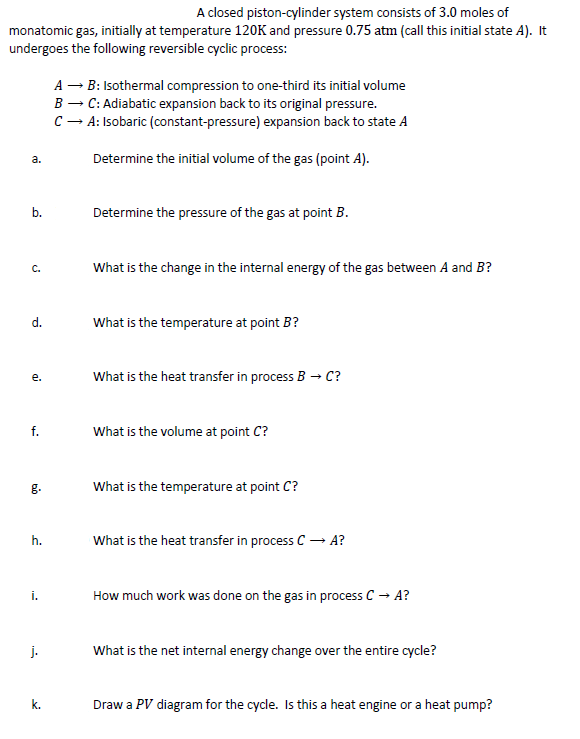Principles of Physics: A Calculus-Based Text
5th Edition
ISBN:9781133104261
Author:Raymond A. Serway, John W. Jewett
Publisher:Raymond A. Serway, John W. Jewett
Chapter18: Heat Engines, Entropy, And The Second Law Of Thermodynamics
Section: Chapter Questions
Problem 16P
Related questions
Question
Answer For D, E, and, F

Transcribed Image Text:A closed piston-cylinder system consists of 3.0 moles of
monatomic gas, initially at temperature 120K and pressure 0.75 atm (call this initial state A). It
undergoes the following reversible cyclic process:
A – B: Isothermal compression to one-third its initial volume
B – C: Adiabatic expansion back to its original pressure.
C - A: Isobaric (constant-pressure) expansion back to state A
a.
Determine the initial volume of the gas (point A).
b.
Determine the pressure of the gas at point B.
What is the change in the internal energy of the gas between A and B?
C.
d.
What is the temperature at point B?
What is the heat transfer in process B → C?
e.
f.
What is the volume at point C?
What is the temperature at point C?
h.
What is the heat transfer in process C – A?
i.
How much work was done on the gas in process C → A?
j.
What is the net internal energy change over the entire cycle?
k.
Draw a PV diagram for the cycle. Is this a heat engine or a heat pump?
Expert Solution
This question has been solved!
Explore an expertly crafted, step-by-step solution for a thorough understanding of key concepts.
This is a popular solution!
Trending now
This is a popular solution!
Step by step
Solved in 5 steps

Knowledge Booster
Learn more about
Need a deep-dive on the concept behind this application? Look no further. Learn more about this topic, physics and related others by exploring similar questions and additional content below.Recommended textbooks for you

Principles of Physics: A Calculus-Based Text
Physics
ISBN:
9781133104261
Author:
Raymond A. Serway, John W. Jewett
Publisher:
Cengage Learning

Physics for Scientists and Engineers, Technology …
Physics
ISBN:
9781305116399
Author:
Raymond A. Serway, John W. Jewett
Publisher:
Cengage Learning


Principles of Physics: A Calculus-Based Text
Physics
ISBN:
9781133104261
Author:
Raymond A. Serway, John W. Jewett
Publisher:
Cengage Learning

Physics for Scientists and Engineers, Technology …
Physics
ISBN:
9781305116399
Author:
Raymond A. Serway, John W. Jewett
Publisher:
Cengage Learning


Physics for Scientists and Engineers: Foundations…
Physics
ISBN:
9781133939146
Author:
Katz, Debora M.
Publisher:
Cengage Learning

Physics for Scientists and Engineers with Modern …
Physics
ISBN:
9781337553292
Author:
Raymond A. Serway, John W. Jewett
Publisher:
Cengage Learning

Physics for Scientists and Engineers
Physics
ISBN:
9781337553278
Author:
Raymond A. Serway, John W. Jewett
Publisher:
Cengage Learning